
PUMPA - SMART LEARNING
எங்கள் ஆசிரியர்களுடன் 1-ஆன்-1 ஆலோசனை நேரத்தைப் பெறுங்கள். டாப்பர் ஆவதற்கு நாங்கள் பயிற்சி அளிப்போம்
Book Free DemoThe picture below shows the communication of the autonomic and somatic nervous system with the central nervous systems.
A somatic neural system and an autonomic neural system are both parts of the PNS.
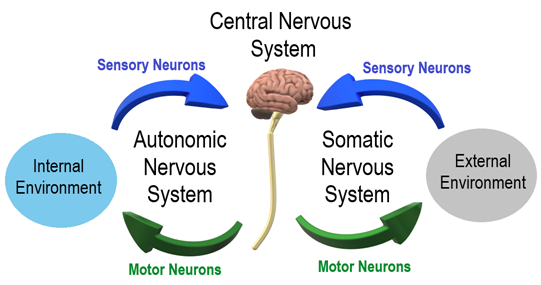
Picture showing the communication of autonomic nervous system and somatic nervous system
Somatic neural system (SNS):
Somatic nervous system: In Greek, soma means 'body'. Hence somatic implies "related to the body".
- The somatic system transfers impulses from the CNS to organs and striated or skeletal muscle to accomplish our daily duties.
- The CNS receives information from the senses and sends it to the somatic sensory receptors.
On the other hand, the somatic motor division receives information from the CNS and uses it to regulate the skeletal muscles. Since this nervous system involves activating voluntary muscles such as skeletal muscles, it is also called the voluntary nervous system.
The somatic neural system contains both afferent and efferent nerves. See the below picture representing the somatic neural process.
- Afferent nerves send information to the brain and spinal cord, which has sensory neurons that inform the central nervous system about our senses.
- Efferent nerves transmit information from the brain, which has motor neurons responsible for voluntary movements like walking or lifting an object.

Picture representing the somatic neural process
Autonomic neural system (ANS):
The autonomic neural system is an autonomic self-regulatory system that controls involuntary organ activities such as cardiac muscles, smooth muscles, and glands.
Example:
It regulates involuntary or unconscious functions such as heart rate, breathing, pupil dilation, regulating glands and internal organs, blood pressure, digestion, and a variety of other chemical processes that keep our bodies running smoothly.
Autonomic sensory receptors receive information from these systems and send it to the CNS, while the autonomic motor division receives information from the CNS and transmits it to these systems. Thus, although the term autonomic implies automatic or unconscious behaviour, some of these activities are consciously perceived and regulated.
Example:
Breathing is a part of the autonomic nervous system, but we can also hold our breath consciously. The autonomic nervous system takes over and governs these functions when people do not consciously choose to control them.
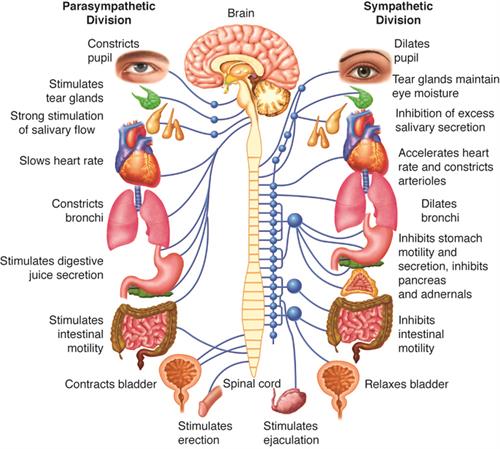
Sympathetic and parasympathetic nervous systems
The autonomic neural system is divided into three subsystems.
- Sympathetic neural system
- Parasympathetic neural system
- Enteric nervous system
Sympathetic and parasympathetic neural systems are constantly trying to shift the body into more prepared and relaxed states. Thus, the body is kept ready for every event by the constantly shifting of control between these two systems.
1. Sympathetic neural systems (SNS):
Do you know why we are so anxious before the start of the exam? Our heart beat increases and we start to breath rapidly in these situations. We perceive the exam situation as similar to that of a dangerous situation. A situation like that is controlled by the sympathetic nervous system, which subsequently increases your blood pressure and heart beat.
The sympathetic nervous system is a portion of the autonomic nervous system found in the spinal cord near the thoracic and lumbar regions. In stressful situations, this system (SNS) prepares the body to react and expend energy.
However, when the body is faced with a potentially dangerous condition, it activates the fight-or-flight response.
Example:
The sympathetic nervous system increases heart rate and breathing to improve oxygen levels, dilates pupils for better vision, slows digestion to save energy, and prepares the body’s muscles to defend or escape. This mechanism is activated not just in life-threatening situations but also in stressful scenarios of our daily life.
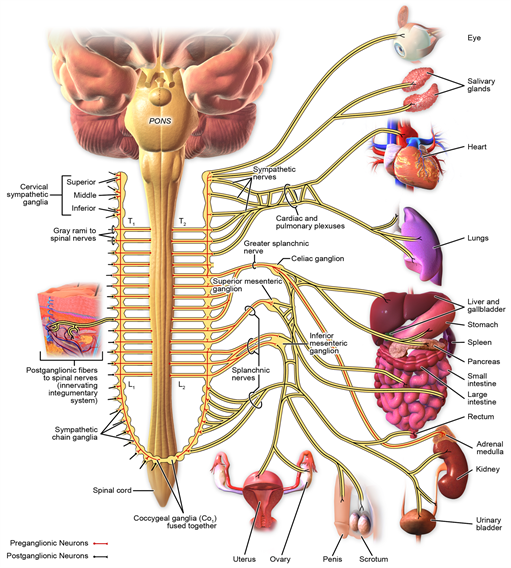
The connections of the sympathetic nervous system
2. Parasympathetic neural systems (PSNS):
During an exam, you may feel stressed, and when you have came out of such a stressful scenario, you may feel more relaxed. This feeling of relaxation is activated by a counterpart of sympathetic nervous system called as parasympathetic nervous system.
The parasympathetic nervous system is a portion of the autonomic nervous system between the spinal cord and the medulla. This system (PSNS) helps the body rest and digest response.
In addition, the mind and body enjoy an experience of calm and relaxation when the parasympathetic nervous system is activated. Thus, it is conserving energy and maintaining functions under ordinary conditions.
After a stressful situation, it undoes the work of the sympathetic division. As a result, it decreases blood pressure, reduces heart rate, and lowers breathing rates while stimulating digestion and other metabolic processes.
However, unlike its counterpart (sympathetic nervous system), this system is slow-acting. It may take several minutes or even longer time to return the body to a relaxed state after a stressful scenario.
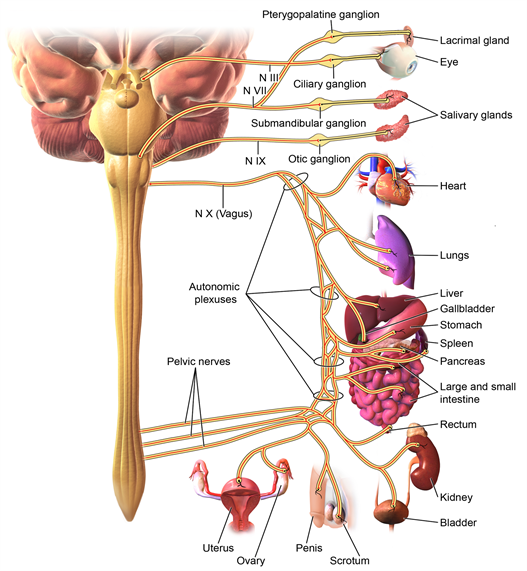
The connections of the parasympathetic nervous system
3. Enteric nervous system:
The enteric nervous system (ENS), also termed the intrinsic nervous system, is one of the major divisions of the autonomic nervous system.
It is composed of a mesh-like system of neurons that controls the gastrointestinal tract's function.
It is the only portion of the peripheral nervous system with large neural circuits that can function independently.
It is the only portion of the peripheral nervous system with large neural circuits that can function independently.
The \(ENS\) has extensive two-way connections with the central nervous system (CNS) and works to control the digestive system in response to local and whole-body physiological needs. The ENS has been referred to and regarded as a second brain because of its size and autonomy.
The below picture shows the different types of nervous systems along with their functions.
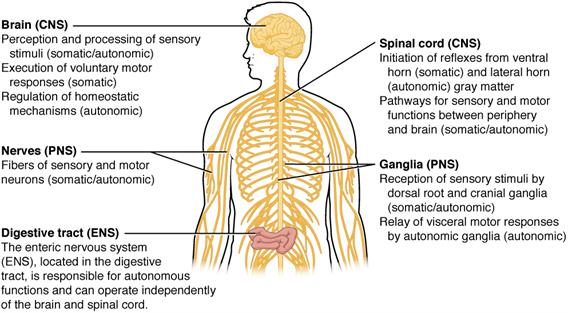
The different types of the nervous system and their functions
ANS is also known as the visceral nerve system. The VNS or ANS is a part of the PNS that consists of the entire network of nerves, fibres, ganglia, and plexuses that carry impulses from the CNS to the viscera and vice versa.
Visceral organs lie within the three \((3)\) central cavities of the body—thoracic, abdominal and abdominopelvic cavities.
Reference:
https://commons.wikimedia.org/wiki/File:Autonomic_and_Somatic_Nervous_System.png
https://commons.wikimedia.org/wiki/File:1507_Short_and_Long_Reflexes.jpg
https://commons.wikimedia.org/wiki/File:Blausen_0838_Sympathetic_Innervation_esp.jpg
https://commons.wikimedia.org/wiki/File:Blausen_0703_Parasympathetic_Innervation.png
https://commons.wikimedia.org/wiki/File:1205_Somatic_Autonomic_Enteric_StructuresN.jpg
https://www.savingstudentsmoney.org/OLI/AnPpost.html